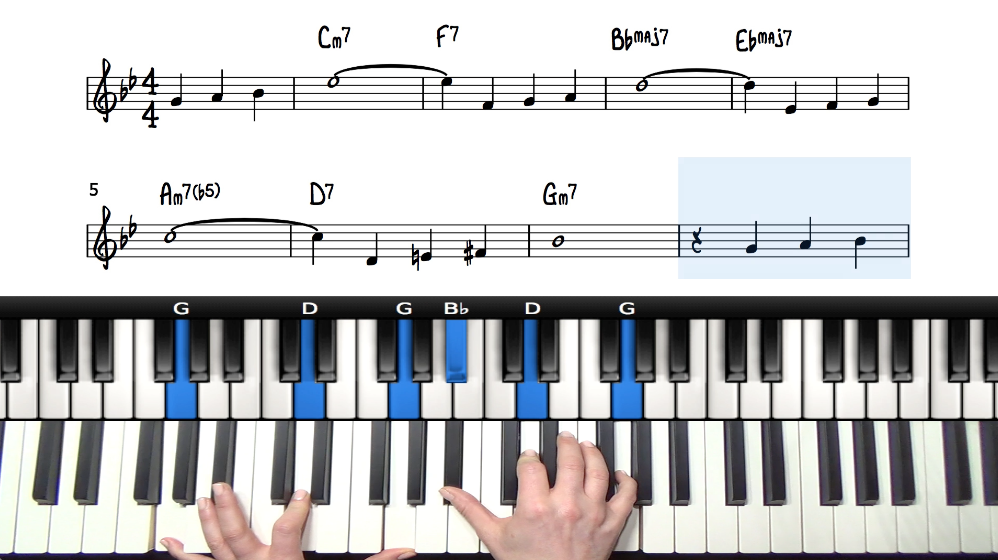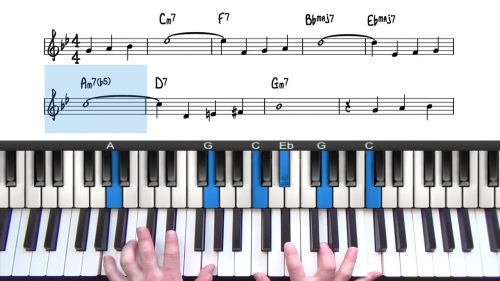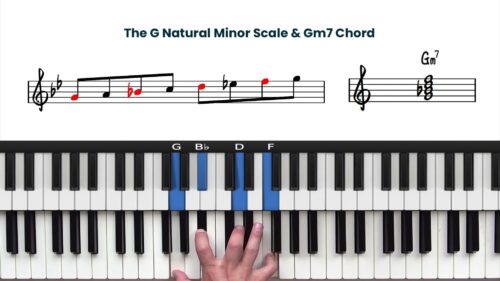Accompaniment Basics: Melody, Harmony & Bass
When accompanying a singer, there are some really easy ways to make that singer shine. That’s the job of the accompanying pianist, to support and enhance the singer’s performance.
In this lesson, we explore the key elements of an effective accompaniment. To do this we will discuss your role in terms of the melody, the harmony and the bass. We will use the tune "Autumn Leaves" to demonstrate and apply the concepts.
Playing The Melody When Accompanying A Singer
An important point is to now lay off the melody when accompanying singers. In the tradition of Billy Holiday, Jazz melodies are not meant to be sung the same way every time, so if you play the melody whilst someone sings the melody, there’s a good chance you won’t be in unison!
Whilst there are some exceptions as we will explore later in the course, the norm is to allow the singer space to interpret the melody, whilst supporting with bass and harmony.
Chords & Voicings For Accompanying Singers
This is an area where many jazz pianists miss the mark. Whilst interesting and complicated voicings are the bread and butter of most jazz, when accompanying a singer, simple is best.
By sticking with the pillars of the chords… 1.3.5.7, you will be giving harmonic support without crowding the airways.
The extensions 9, 11 & 13 and their alterations add color that jazz cats love, but they can very easily clash with the melody, making the singer sound flat, or sharp, when in reality, it’s just disharmony.
Simple voicings often work best here. We will explore the exact types of voicings that work well and apply these to the form of Autumn Leaves.
The Importance Of The Bass
Assuming you don’t have a bassist, you will need to add the lower end as the singer will be much more in the middle ranger of the piano.
Adding the bass creates a floor underneath that will make a more complete sound for the voice stand apart from. It also helps keep the singer squarely rooted in their melody line. Singers often need to hear the 1 in the bass. They rely on this.
Lesson Downloads
-
Triads Notation & Worksheet File Type: pdf
-
7th Chords In All 12 Keys File Type: pdf
Practice Tips
-
Stay away from chording too much in the lower registers of the piano. This can overpower the voice not only in volume but also the complexity of sound waves.
-
Playing octaves in your left hand is a nice way to create a full sounding bass.
-
Whole notes rhythms on the root of each chord works great. You can keep a steady rhythm in your left hand for the singer to feel and lean on at times.
-
It can be a challenge to strip your voicings back down to the primary chord tones and this will take time and patience for you to master.
-
As an exercise, learn to play through the whole form of Autumn Leaves without including any extensions or alterations in your voicings.
-
Work on 8 bars sections at a time and then add everything together.
- Remember that you can also play with the iRealPro app to ensure that your timing and tempo is accurate.









This is very clear, useful information. I am learning a lot. Thanks !
Awesome, thanks for letting us know Natasha! :-)
Hi Lyndol / Hayden, I would like to ask about using extensions when accompanying singer, in the beginning do you also recommend to avoid 7th notes and to use just simple triads or is 7th fine? When is it fine to use extensions – only during fills and solos? And finally how is it with accompanying other instruments – I suppose that it is fine to use extensions during comping while other instruments has a solo or is it similar like with singers or how is it?
Hi Martin,
To start with, I would recommend just sticking to the triads. This will ensure that you are not clashing with the singer and that you are including the pillars of the chord in your voicings. Keeping things simple to start will help you listen to the singer and build some rapport with their style.
The next step is to start to add in 7th chords. Focus on smooth voice leading so that your accompaniment sounds connected and smooth underneath the singer.
Triads and 7th chords are both safe choices. Start with triads and then gradually introduce 7th chords so that you are in control of what you are playing and so that you can hear the difference between triads and 7th chords.
Yes that’s correct that you can include extensions, alterations and blues notes in your fills, and solos. In that space, you can get more sophisticated with your voicings choices.
Regarding comping under soloists: it depends on the setting and the soloist. Much of the same principles apply, if you are ever in doubt, start simple with just triads and 7th chords, and then gradually layer in extensions to ‘test the water’ on how they sound. You always want to be in support of the soloist, no matter the instrument. Simple voicings of triads and/or 7ths will give them space to express, and then you can follow their lead. When you are really connected in with a soloist, you’ll know when and where to get more sophisticated (and colorful:)
Hayden’s upcoming course on “Playing in a jazz band” will cover the different types of voicings you can use in a band setting, and more specifically, when accompanying other instruments.
Does this address all your concerns? Please don’t hesitate with more questions if not.
– Lyndol
Thank you very much Lyndol for your answers, all concerns are addressed.
Fantastic! Glad to hear it Martin!
Thanks for this Lyndol – this was super useful. I like to have the option of using rooted voicings to accompany myself singing (no band, except sometimes iReal Pro as a proxy band!) and the tip about keeping things simple was really helpful, thanks!
This is awesome..recently i learned a tom jobim song called chega de saudades for piano and voice..i learned it by ear listening to jobims playing..and now i can really understand what he was doing!Awesome
But what should i do if i have a singer and musician playing bass?Rootless voicings?
Yes that’s right, rootless voicings would be a good choice.
When playing with a bass player, you can still play the roots of the chords occasionally and that would not be a problem.
But if you play the root all of the time, then you would be doubling the bass note which does not add anything to the harmony.
Instead you could focus on adding fills to complement the singer – this is a role that the bass player is not doing, and so it makes sense for the piano to take that role.
Hope this helps!
Cheers,
Hayden
👏👏👏
I think this type of vídeos will help greatly in learning this new concepts because they are everywhere and helped me greatly to see them in action …
Awesome, thanks for sharing Ivan…. beautiful recording.
That’s awesome Ivan…. i understand how great those ‘moments of discovery’ feel!
Cheers,
Hayden
Thank you so much Lyndol (and Hayden od course)!
This lesson is a perfect starting point, when it comes to creating my own arrangements to accompany my wife (not yet married ;) )…
I have to confess, that for me as a jazzpiano newby this lesson alone seems like a whole course (kind of 101) in accompaniment…
In other words: It‘s a bit overwhelming to digest all the information, presented in this one video.
What could help me (and perhaps others also) is a sort of step-by-step assignment list for all the things covered in this lessons…
Not sure, if I‘m clear here?!?
Perhaps someone has an idea
Thanks in advance
Michael
Hi Michael,
Thanks for your message. My apologies for the delay in response. A few things have fallen thru the cracks due to current global events.
I’m wondering if you would still like that list? I am happy to work on that if so. Sounds like a good idea, since overwhelm can be a real block to moving forward and just knowing the first, then next step to take is best way to overcome it. I’m sure others can benefit too!
I think that’s so cool you are accompanying your wife to be! How lovely and I’m sure you guys are creating music very connected and full of chemistry – that can be the rarest and hardest part of music to find!
So please let me know how I can help you with where you are at now and all the best!
– Lyndol
Hi Michael – Update, per your request, I just created an action list for the above video. I hope this is helpful to you and others. Please let me know if you have questions.
1) Learn the melody in right hand. Though you won’t be playing it, it’s important to be familiar with it before you start working Basslines and Harmonies since it will be the glue for both. Also, it can come in handy should you need to guide your singer (if they get lost), or play a bit of the melody in the intro to get the singer off to a strong start, ect.
* If you are a singing pianist, singing along with the RH is advised first on Ah, then lyrics
2) Bass Line with Left Hand – add in a metronome, even if slow, as soon as possible
Step A – Play the 1 (tonic) in Whole Notes all the way through
Step B – Play the 1 in octaves, in Half Notes all the way through
Step C – Play with 1. 5 bass or 1. 5. 1 Bass lines
Step D – Use arpeggiated pillars of the chords as basslines, 1.3.5.7
Step E – Repeat any of the above bass lines with differing rhythms (See examples below)
Step F – Mix and match different approaches + play around with the tessiture
3) Harmony/Chording with Right Hand – add in a metronome, even if slow, as soon as possible
Step A – Triads (1.3.5) in Root position
Step B – Triads in Inversions – 1st, then 2nd
Step C – Mix and match rootless/inversions triads, using voice leading, try different tessitures, experiment
Step D – 7th Chords (1.3.5.7) in Root position
Step E – 7th Chords in Inversions, 1st, 2nd, 3rd
Step F – Mix and match rootless/inversions, using voice leading, try different tessitures, experiment
Pacing Schedule – Once you know the melody, you can:
Take Step A from both #2 and #3, and work separately.
Then put them together.
Then the next day, review with Step A, then push forward with Step B in the same way.
Repeat with each step.
Adjust the schedule to challenge yourself, but not cause overwhelm. Stay on a step as long as you need.
You can add in the melody (either as the singing pianist or accompanying a singer) on Step A – once you feel comfortable enough.
Great lesson it helped me a lot since I always practice by myself with solo piano and every one in a while I go to a friend who is singer and I always piss him off cause I play all the melody and stuff :)
So I’m sure next time I’ll visit him he’ll be pleased with my progress :)
BTW – It also sounds nice just doing songs as if you accompany someone when your alone :)
Wonderful Ariel! So glad to hear that it’s helpful for when you accompany your friend, as well as play solo! Win win! I hope to hear more about how the next session with your friend goes.
And if you have any questions or concerns, don’t hesitate.
Cheers and happy playing,
Lyndol
Hi Lyndol,
Great lesson. I am so happy to hear to keep the voices simple. :-) I have worked so hard to examine all of the useful color tones when voicing the melody. Now you’re teaching me to lay back…that’s EASY!
Thank you, and of course Hayden as well. Life rarely gets simpler. :-)
HI Glenn,
SO glad you can get something out of my lesson for your playing style.
I do find that so many of us who study jazz as adults tend to overthink and overplay – especially in improv.
Going back to the basics allows for more expression and more musicality. It is often easier than we think (as long as we’ ve put the work in)
It’s easy to get caught up in our intellect, but music is so much more than even a language. And in order for the magic to occur, we want to be in the zone. It’s a mindset, but when we are in the zone – the music does seem simple and easy to us.
“Trying too Hard” is one of the most common ways to lock yourself out of that zone.
So yes – lay back and enjoy your music. And you’ll find that the complexities you want to add come very naturally as you build up slowly and elegantly. The ideas will flow easily and effortless – as long as you are not “trying” too hard.
Speaking of, it’s hard to put this into words!
But thanks again for reaching out. And best of it for your music!
– Lyndol